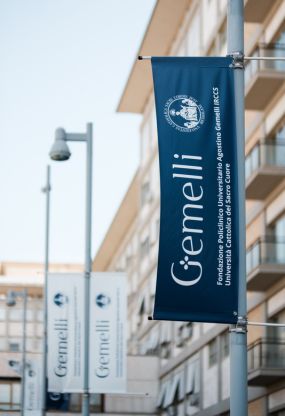Accredited School
The specialist in Dermatology and Venereology must have acquired theoretical, scientific and professional knowledge in the field of anatomy, genetics, statistics, histocytopathology, pathophysiology, allergology, microbiology, virology and medical mycology, clinical and therapy of skin diseases of the developmental age and adulthood, infectious diseases of pre-eminent skin interest, surgical dermatology, general and applied pharmacology, dermatological angiology, sexually transmitted diseases, diagnostic and therapeutic photodermatology, forensic medicine applied to dermatology, oncology and dermatology. They must have gained the technical skills relating to the aforementioned areas and for the application of specific diagnostic and therapeutic methodologies
Basic educational objectives: the student must acquire the fundamental theoretical knowledge of physiology, biochemistry, as well as techniques in all areas of laboratory and diagnostics applied to dermatology and venereology, including cytopathology, histopathology, immunopathology, ultrastructural diagnostics, diagnostic imaging, dermatological microbiology and mycology. To this end, he/she must deepen his/her knowledge of Anatomy, Physiology, Pharmacology, Physics, Statistics, Epidemiology, Computer Science, Genetics, as well as acquire advanced knowledge of the etiopathogenic mechanisms that determine the onset of skin diseases and skin appendages;
Objectives of general training: the student must acquire the correct statistical approach and the methodological-logical bases of the laboratory, clinic and therapy, as well as the ability to continuously renew their professional knowledge, also through the use of up-to-date information technology;
Objectives of the School typology: acquisition of the fundamental theoretical and technical knowledge necessary for the epidemiological evaluation, for the prevention and for the diagnosis and therapy, including surgery and physiotherapy, of skin diseases and pediatric dermatology, immunological diseases with prevalent cutaneous expression, skin neoplastic diseases; participation in controlled clinical trials according to the standards of good clinical practice; acquisition of communication and relational skills with the patient and family members and the ability to interact with other specialists; acquisition of the fundamental theoretical and technical knowledge necessary for the epidemiological evaluation, prevention, diagnosis and treatment of allergic, occupational and environmental diseases; acquisition of the fundamental theoretical and technical knowledge necessary for the evaluation of the epidemiology, prevention, legislation, diagnosis and therapy, including physical therapy, of sexually transmitted diseases including AIDS: acquisition of theoretical and practical knowledge relating to instrumental assessments of physiological parameters of the skin, functional tests and the diagnosis and treatment of skin imperfections, professional ethics and health legislation and for the prevention, diagnosis and treatment of tropical dermatological diseases (including those arising on Caucasian skin) and cosmopolitan dermatological diseases arising on black skin; acquisition of the fundamental theoretical and technical knowledge for the diagnosis and therapy of dermatological diseases susceptible to surgical treatment.
The following are compulsory professionalizing activities for the achievement of the educational purposes of the type:
a) execution of at least 40 skin biopsies;
(b) assessment of at least:
- 100 microscopic and cultural examinations of biological material;
- 30 serological tests for STDs;
- 30 histological and immunopathological examinations;
- 10 cosmetological dermatology tests (pHmetry, sebometry, elastometry, trichogram, etc.);
- 60 allergodiagnostic skin tests;
- 50 Epiluminescence examinations.
c) taking charge (with direct participation in diagnosis, therapy and evaluation of results) of at least 400 cases of dermopathies of which:
- 220 cases of general dermatology;
- 50 cases of immune-allergic dermatology;
- 50 cases of STDs, infectious and parasitic diseases;
- 50 of oncological dermatology;
- 30 of childhood dermatology and geriatrics.
(d) the execution or first aid of at least:
- 80 dermatological surgeries, including the preparation of the patient for surgery, local or district anesthesia and the postoperative course;
- 100 physical therapy treatments (cryotherapy, phototherapy, diathermocoagulation, LASER treatments );
- 20 intralesional injection treatments.
Integrated training objectives (i.e. common trunk): the student must have acquired satisfactory theoretical knowledge and professional competence in the clinical and instrumental diagnosis and treatment, even in emergency-urgency conditions, of the most common internal pathologies. The student must acquire the fundamental knowledge of the pathophysiology of the various organs and systems, the theoretical and practical knowledge necessary for the recognition of diseases affecting the different systems of the body, the theoretical and practical knowledge of the main sectors of instrumental and laboratory diagnostics related to the aforementioned diseases, the acquisition of the ability to evaluate internal and specialist connections and influences. He must therefore be able to recognize the symptoms and clinical-functional signs with which diseases of various organs and systems manifest themselves, having acquired the fundamental diagnostic, therapeutic, psychological and ethical knowledge necessary for a global vision of the patient. To this end, the ability to clinically frame the patient on the basis of the anamnesis and physical examination must mature; develop critical and analytical diagnostic skills; become familiar with the main diagnostic procedures and laboratory-instrumental investigations; recognise and be able to deal with major medical emergencies; familiarize themselves with therapeutic resources in order to plan their optimal use and recognize their indications and contraindications, as well as the effects of interaction and possible iatrogenic accidents; acquire the fundamental notions relating to clinical research methodologies and pharmacological trials; know the fundamental problems related to prevention, public health and social medicine. The resident must have acquired satisfactory theoretical knowledge and professional competence in the recognition and treatment, in emergency-urgency conditions, of the most common pathologies. Finally, the resident must also know, from a clinical and therapeutic point of view, the most common pathologies of competence of the other types of the class.
The student will be able to compete for the diploma after completing the professionalizing activities.
As part of the training course, the student will have to learn the scientific bases of the type of School in order to achieve full maturity and professional competence that includes an adequate ability to interpret scientific innovations and critical knowledge that allows him to consciously manage both assistance and his own updating; In this context, participation in meetings, congresses and the production of scientific publications and periods of attendance in qualified Italian and foreign institutions useful for his/her training may be envisaged.




